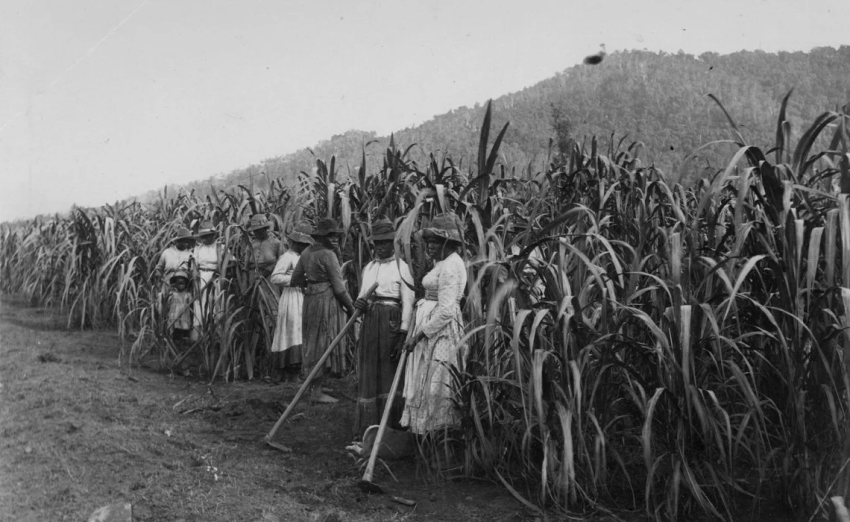
“When you capture people, and put chains around their necks, and make them walk 300 kilometres and then set them to work on cattle stations, what’s that called?” asked the award-winning author Bruce Pascoe after Prime Minister Scott Morrison stated that there had been no slavery in Australia.
“That’s what happened in Western Australia and in the [Northern] Territory and in Queensland,” said the adjunct professor at UTS Jumbunna Institute for Indigenous Education and Research.
The public backlash condemning Morrison for his historical amnesia forced him to acknowledge that “all sorts of hideous practices” had taken place since European colonisation.
A lid has been lifted on the culture wars, fuelled by the right, which actively seeks to diminish the fact that colonisation was based on the notion of terra nullius which guided dispossession and genocide of Aboriginal people and, subsequently, the use of racism.
Australia was a penal colony, established by Britain in 1788 in an effort to replace the settlements lost after the United States War of Independence of 1776. The convicts were the equivalent of slaves, forced to endure backbreaking work for meagre rations and subject to mistreatment, torture and death.
Simultaneously, First Nations inhabitants were forcibly removed from being the custodians of land for at least 60,000 years. They were subjected to genocide by a smallpox pandemic, arguably consciously introduced by the British colonial authorities, as well as mass murder perpetrated by both troops and gangs of white settlers.
“Slavery, indentured work and stolen wages aren’t just an ugly part of Australia’s history — they’re the basis of much of our early economic growth,” Amber Schultz and Georgia Wilkins wrote in the June 12 Crikey. “The fact is, either through slavery, servitude, exploitation or stolen wages, Aboriginal and Torres Strait Islanders — and men [sic] kidnapped from Melanesia — played a massive role in developing Australia into the wealthy country it is today.”
From domestic servants and sex slaves on cattle stations and cane fields, Australia’s pastoral land was developed largely thanks to the exploitation of First Nations people. Legally, slavery was abolished in 1833 in most British colonies — although authorities often ignored the illegal slave trade.
Related forms of slavery continued to flourish throughout Britain’s colonies, however and its industry continued to rely on wealth derived from the slave-owning US South for decades after that.
Just as the American Civil War was being fought to free the US slaves, another variant of slavery was introduced in Australia: it was known as “Blackbirding”.
As socialist historian John Tully said in "From the First Fleet to Stopping the Boats: Racism and Resistance": “Racist dogma ... insisted that whites could not perform heavy manual labour in the tropics. This presented something of a conundrum for white employers and they cast their eyes overseas for a source of cheap labour.
“From the 1860s, some 60,000 South Sea Islanders — the so-called Kanakas — were brought to Queensland from the Solomons and other islands as indentured labourers to work the sugar cane fields. The system was known as ‘blackbirding’ and the human traffickers as ‘blackbirders’.
“The indentured labour system was common across the colonial world ... [and] was, as Frederick Engels observed, ‘little more than disguised slavery’.”
Tully said that many Islanders taken to Queensland “were tricked or taken by force aboard the blackbirders’ ships”. He added that the trade only ended, ironically, because of the White Australia Policy. “After the Pacific Islands Labourers’ Act was passed in 1901, most of the Islanders were repatriated to their homelands, although some 4000 of their descendants remain today, mainly in the Bundaberg region.”
From early colonisation to the 20th century, Indigenous Australians often worked on farms for rations instead of wages. They were traded among settlers and their children were often taken and moved across the country to work.
Aboriginal and Torres Strait Islanders were also employed illegally, for no income, until 1972. Last July, about 10,000 Indigenous Australians received $190 million in “stolen wages” from the Queensland government in recognition of this fact.
NITV on June 11 hosted Richard Weston, CEO of the Secretariat of the National Aboriginal and Islander Child Care, who listed famous cases of Indigenous slave labour and Indigenous resistance, including the Gurindji walk-off from Wave Hill Station in 1967.
In 1883, 3000 kilometres of Gurindji land in the Northern Territory was granted to a pastoralist by the colonial government. “Working in the pastoral industry for close to 100 years, they weren’t paid,” Weston said. “They lived in appalling conditions on their own country, you know, supporting these multi-million dollar industries, supporting pastoral leases and rich people from Europe ... that’s slave labour.”
The West Australian pearling industry from the 19th into the early 20th centuries also relied on Aboriginal slave labour. Slave traders would round up Aboriginal men at gunpoint and sell them to pearling captains, who would force them to dive for pearl shell on pain of injury or death.
Slavery, as a system of forced labour, dates back to antiquity. Slavery, Australia-style, includes the original convict system, First Nations people being forced to labour on pastoral stations, the Blackbirding of South Sea Islanders and the Stolen Wages program in Queensland and other states.
While wage theft is the capitalist system’s standard business model and the colonisers generally accepted slavery, it nevertheless sat uneasily on their conscience. This is why the ideology of “scientific” racism, the belief that one skin colour was superior to another, allowed First Nations people to be enslaved for so long. It also underpins the right’s culture wars, currently taking a hammering with the rise of the Black Lives Matter-Stop Deaths in Custody movements.
[Jim McIlroy is a member of the Socialist Alliance.]